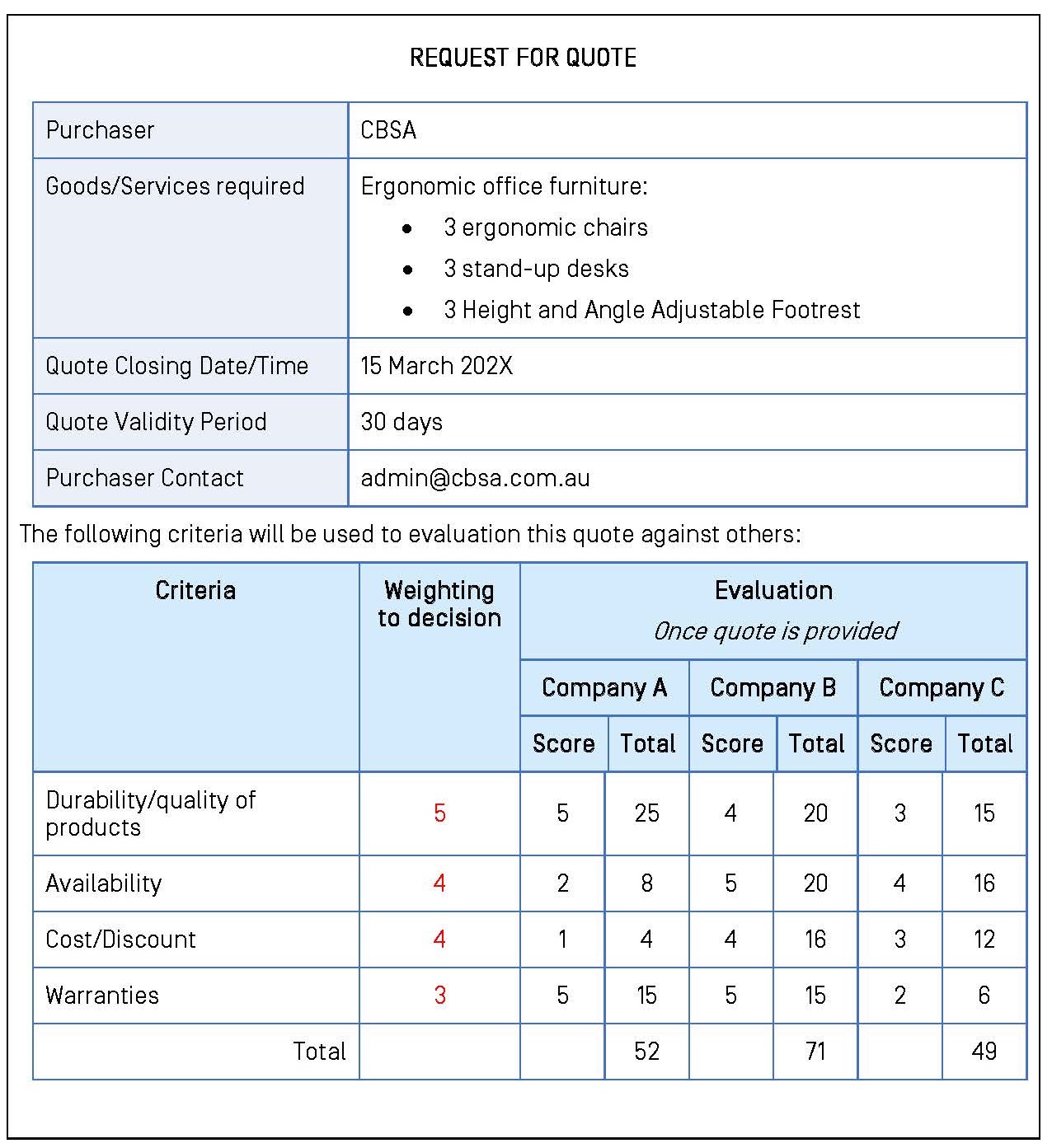In this topic, we will be taking a look at employee recruitment, induction strategies as well as physical resources and service acquisition strategies.
We will then explore the legislative and regulatory framework relating to the operational plan.
By the end of this topic, you will understand:
- What human resourcing is and why it is important for businesses
- The difference between internal and external recruitment
- The five (5) key steps in the recruitment process
- The three steps in the applicant assessment process
- What is meant by procurement of resources and the key steps in the procurement process
- The importance of Workplace Health and Safety and its role in operational planning.
What is human resourcing?
Human resourcing refers to both the people who work for a company or organisation and the department in charge of managing resources related to employees.
Human resource management is an overarching term used to describe how employees are managed and developed in an organisation.
In this section, we will cover what human resourcing is all about, including job descriptions, internal or external recruitments, as well as the recruitment process.
I am convinced that nothing we do is more important than hiring and developing people. At the end of the day, you bet on people not on strategies.Lawrence Bossidy
What is human resources (HR) all about?
To run any kind of business, whether it is selling a product or providing a service, people are needed. Employees are vital to this profit-making process. However, you need to ensure that you have the best people doing the right job for the correct pay so that your business runs at a profit.
Here is an outline of the process for hiring employees:
- Create a job description
- Consider internal versus external recruitment
- Determine internal resource needs
- Undertake the recruitment process.
The next few sections describe how each of these four (4) steps operate.
Creating a job description
Prior to hiring someone, or replacing an employee, you must document your expectations for that individual in return for the pay they will earn:
- Outline the specific tasks and/or projects that need to be achieved to fulfill the team goal
- Record how you intend to assess the individual’s progress towards these
- Base payment on several factors, such as budget and market averages.
If you would like to retain the employee, you will need to provide a salary that is reflective of the market norm or higher.
Resource
Click here to access and download a job description template developed by Fair Work Australia.
Internal vs. external recruitment
Once an organisation has determined that there is a need for more human resources to grow the business, they may search for internal candidates first.
This can be of value in some instances. The human resources team might ask these preliminary questions to determine internal capabilities:
- Are there capable internal resources?
- Are the internal resources available?
- Do they need to be trained?
Example
A restaurant needs additional human resources to staff a couple of managerial positions.
The restaurant may do an internal search for assistant managers who are experienced enough to fulfill a management position. The advantage is that the current employees know the business and customer experience better than a new candidate.
In order to build a rewarding employee experience, you need to understand what matters most to your people.Julie Bevacqua
Determining internal resource needs
To determine internal resource needs, a skills gap analysis can identify gaps in skills across teams and departments.
A skills gap analysis is a tool that:
- Is used to assess the difference (or gap) between the actual state and a future, goal state
- HR can implement to find out which skills and knowledge are lacking among the employees in the organisation.
Skills analysis diagram
The recruitment process
This is the general process of recruitment commonly followed by organisations:
What do we require the person for?
Position description and responsibilities
Advertise internally, externally or both
Screen applicants to determine those that might be applicable
Give the candidate a chance to display their knowledge and personal skills
Yay! You have successfully recruited!
Watch
Watch the following 4-minute video to learn more about the recruitment process and selecting the right candidate:
Reading
This article, ‘The 10 Most Critical Recruitment Process Steps’, explores the most important steps in the recruitment process.
This article, apart from the above-mentioned recruitment process steps, emphasizes the importance of new employee onboarding as the last step of recruitment. According to this article, a comprehensive onboarding process is perhaps the most crucial step in the recruiting process. This includes an induction process, setting up workstations, introducing team processes and members, and providing necessary resources, but also a training program that enables new employees to integrate into their new roles and be able to perform as the rest of the team, within a short time. We will talk about the induction process in the next section.
Check your understanding

How to assess applicants for your recruitment needs
Applicant assessment refers to the process an employer undertakes to determine whether they are suitable for the role they have applied for.
This assessment can take many forms including a review of the candidate‘s resume and cover letter, a pre-selection process, a formal interview, various online tools including skills and behavioural assessment, and personality tests as well as social profile reviews.
The complexity and seniority of a role can determine the extent to which these assessments are included in the hiring process.
In this section, we will take look at the overview of the process for selecting an applicant, from the screening process to interviewing and selection.
There are three (3) main steps to the process of ultimately selecting an applicant for a position:
- Screening — Reviewing applicant documents for roles
- Interviewing — Meeting with potential applicants
- Candidate selection — Choosing the right applicant
Read on for more information about each of these three steps:
Screening
Applicant screening is the procedure for assessing job applications. This occurs straight after candidate sourcing and entails skimming through resumes, and cover letters to identify the best applicant-job-description matches in terms of qualifications, experience, skill sets and projected candidate-organisation fit.
Screening involves reviewing:
- Cover letter: A letter in which the applicant introduces themself and addresses the requirements of the job advertisement (also known as selection criteria).
- Resume: Provides a summary of the applicant, including work history, skills and formal education.
- Application form: Designed to collect a summary of applicants’ skills and knowledge.
Watch
Watch the following 2-minute video to learn more about screening applicants:
Employees engage with employers and brands when they’re treated as humans.Meghan Biro
Interviewing
An interview is basically a structured conversation in which one participant asks questions and the other provides answers.
Typically, the word interview refers to a one-on-one conversation that happens between an interviewer and an interviewee. It is also a means to determine whether a candidate is appropriate for a job role.
Main types of interviews are:
- Screening: Designed to eliminate applicants that are unsuitable for some reason.
- Preliminary: Shortlists the applicants that made it through the screening process. Many selection process consists of multiple rounds of screening where candidates are tested on their skills and abilities.
- Final: Selects the applicant to hire for the position.
When arranging interviews, there are a few factors you need to consider:
- Step 1: Preparation - Preparing for the interview includes determining the schedule, what questions to ask, the location and scheduling the interview time with everyone you want on the decision panel.
- Step 2: Questions and answers - Making sure you ask the right questions to give you a robust sense of whether this is the right candidate. Also being prepared to answer any questions the candidate may have about the role and the business.
- Step 3: Body language - This may include the second round of interviews, reference checks or criminal record checks.
Applicant selection
Applicant selection is the final step in the recruitment process and comes after a lengthy and thorough review and analysis of the best applicants for the role. Reference checks are also completed at this stage to obtain confirmation from previous employers regarding the candidates skills and work performance.
Choosing the right applicant will be based on a number of factors and is usually a decision made by more than one person; each individual involved with the recruitment process will usually make their recommendations.
Watch
Watch the following 10-minute video to learn more about applicant selection:
Scoring applicants for selection decisions
Interviewers need to evaluate the final round of candidates by asking, “Who best meets the desired criteria?” The candidate needs to balance job skills and experience with personal skills.
Also, interviewers need to determine if the final candidate is a good fit for the team, culturally.
Many organisations use scoring tools, such as the Selection Decision Diagram.
Review the following example:
Selection decision
- Who best meets the desired criteria?
- Skills and experience versus personal skills.
- Does the candidate fit into the team?
- Salary expectations?
- Goals for the future?
| Q1 | Q2 | Q3 | Q4 | Q5 | Totals | |
|---|---|---|---|---|---|---|
| Person 1 | ||||||
| Person 2 | ||||||
| Person 3 | ||||||
| Person 4 |
Key points
Scoring should be implemented based on the candidates’ performance against each Person's Specification Criteria. Determine at the beginning how many marks you would like to give for each Person's Specification Criteria.
Applicant selection assessment methods
Sometimes, it can be difficult to choose the very best applicant. This can be a result of the function of the role and the need to ensure the person is very capable, or it might be down to the recruitment panel not being able to form an agreement on who to hire.
There are various assessments that can be given to the applicant for further exploration of their skills and aptitude for the role to ensure they are a strong fit for the position.
These assessments can also help to clarify their skill set with detailed insight.
Three (3) potential assessment methods are:
- Aptitude tests: Tests the cognitive skills of the applicant.
- Medical test: Tests the medical health of the applicant.
- Psychological test: Tests the psychology of the applicant.
Watch
Watch the following almost 2-minute video to learn more about testing and selection methods:
Check your understanding

Understanding the induction process
An induction process—or programme—is used within many businesses to welcome new employees to the company and prepare them for their new role.
It helps in the integration of employees into the organisation and educates them about their role, their team and the company as a whole.
Induction is an important part of the recruitment journey.
The importance of effective induction for new employees
Induction is a learning program that provides the new staff member with all the information needed to fulfill their new job.
This is a lot of information, so it needs to be given at the right speed, to optimise understanding over the months to follow.
An induction program usually runs as part of a new employee’s probation period and can last anywhere between a few days, to a few weeks or even months. A successful induction will cover a range of activities and information the new employee needs to know, such as:
- Meet and greet
- Introduction to team
- Organisation overview
- Work policies
- Work health and safety requirements
- Role and expectations
- Process compliance
- Performance standards
- Review and feedback
If you think it’s expensive to hire a professional, wait until you hire an amateur.Red Adair
The induction process
Effective inductions are timely, organised and engaging, and give new employees a great first impression of a company. They should inspire new staff to follow the organisation’s mission and vision and educate them about the company’s history, culture and values.
If done well, the induction process will allow a new starter to lay the foundations for important relationships within the team and across the wider organisation.
Note
Induction is either an informal or formal process.
The induction process:
- STEP 1. Follow a checklist schedule to ensure new employees gain the required information during the induction. An induction plan/checklist usually contains information about the employee and the topics that should be covered during the induction. Induction checklists/plans usually require employees to sign the form once induction is completed – this is as a form of evidence that the induction process has been completed and the topics covered. Click here to access an example from Far Work Ombudsman. Alternatively, click here to view another example from the Tasmanian Department of State Growth.
- STEP 2. Welcome employees to the organisation to introduce the mission and vision of the organisation. It is important that employees understand the role they play in an organisation. Companies usually organise informal meet-and-greet meetings where new employees can meet and talk to members of the different department to understand a bit of about each department’s work.
- STEP 3. Welcome employees to their work team to ensure that new employees are introduced to the immediate team they will be working in.
- STEP 4. Orientation ensures that new employees learn how to use facilities and equipment required for their job.
- Step 5. Policies and procedures in place must be introduced to new employees. It is important for new employees to learn where to access organisational policies and procedures so they can implement them in practice. Work health and safety policies and procedures are one of the most important policy and procedure documents. Many companies develop online inductions for employees where they also get tested in their newly acquired knowledge about workplace procedures. This is a fun and interactive way to inform new employees and also record their interaction with the topics covered and their knowledge of workplace procedures.
A little effort from the management and a well-planned induction is essential to reap all the benefits, quickly. Induction is not an option, it is an investment, and every company no matter how small or big should make this investment.People Works
Resource
On Fair Work Ombudsman’s website, you can access a free online learning centre that will teach you skills and strategies to help you at work, both as an employee and as a manager.
Here are some examples of the free courses. They usually take 20-40 minutes to complete.
- Difficult conversations in the workplace - employee course
- Starting a new job (as an employee) - This course helps you understand your rights, questions that can be asked during an induction and types of behaviour expected in the workplace.
- Difficult conversations in the workplace - manager course
- Hiring employees – This course provides general guidance on hiring and induction process and how to mentor and coach new employees.
- Managing employees - This course will help you develop your people management skills, so you can build a high-performing team and help your business achieve its goals.
- Managing performance – This course contains practical information about how to set up a performance management system, how to conduct performance evaluations and how to motivate employees.
- Workplace flexibility - This course will show you how to make flexibility work for your business.
Check your understanding

What is the procurement of resources?
Procurement is the act of acquiring goods or services— usually for business needs.
Procurement typically refers to the final act of purchasing, but it can also be used for the procurement process overall, which can be very important for companies as they make their final purchasing decision.
Procuring resources is an important part of the planning process.
In this section, we will look at what are physical resources, procurement policies and the purchasing process.
Procuring physical resources
Most managers must be accountable for a plan regarding how they will allocate money annually.
For each dollar spent, a strong justification must be given in relation to the return and impact the money outlaid will have on the organisation’s goals and profits. If the reasons given are accepted, the provision will be included in the budget.
Note
Physical resources are things like goods and services necessary for human resources (employees) to perform their job duties.
Factors to look out for when planning for physical resources are:
- It is not unusual for managers to spend money on machinery or services throughout the year that was not planned in the budget
- This expenditure is not encouraged and others may query the need for such spending in regard to the organisation’s overall vision
- After all, if it was part of the overarching plan it would have been included in the budget; unnecessary spending that is not well considered can cause high expenses and low profits.
The nation behaves well if it treats the natural resources as assets which it must turn over to the next generation increased; and not impaired in value.Theodore Roosevelt
Procurement policies
Companies create procurement policies so they can monitor the purchasing of physical resources.
A procurement policy should ensure:
- Open competition
- Value for money
- Fair trading
- Sustainability concerns are addressed
- Risk is managed.
Review the following diagram to learn more about the steps within a procurement policy. We’ll learn more about this next:
The purchasing process
Purchasing is the formal process of buying goods and services.
Suppliers send their quotations in response to the request for the equipment, goods or services that have been requested and a review is undertaken where the best offer (typically based on price, availability and quality) is given the purchase order.
Following on from purchase policies—there are key steps in the purchasing process:
- Step 1: Identify the need
- Step 2: Specify the requirement
- Step 3: Find and choose a supplier by requesting quotes and selecting the best offer based on factors such as cost, reliability and delivery time.
- Step 4: Negotiate costs (this is often possible when placing high-priced orders or orders that can recur regularly)
- Step 5: Get order approval. Approvals are usually required in case of high-price orders. As price is an important factor, approvals are requested once quotes have been collected (so upper management can make an informed decision).
- Step 6: Place the order. It is important to have everything in writing and always keep a copy of the agreement for future reference.
- Step 7: Receive and approve order to ensure there are no issues with the product or anything the supplier failed to deliver on.
- Step 8: Review supplier performance to ensure you continue the relationship with suppliers who continue to meet your business’s needs.
Watch
Watch the following 3-minute video to learn more about the key steps in the purchasing process:
Resources
The following resources give an example of how to request quotes and how to evaluate the quotes received:
Here is an example of a completed Request for Quote form:

As you can see in the example above, the Request for Quote form captures purchaser’s information, the good and services required and it outlines the criteria used for evaluation as well. A score is given for each criterion based on its importance (5 is being the highest importance and 1 being the lowest). Once quotes are provided, each company receives a score based on what they offered in their quotes. The company’s individual scores get multiplied by the scores determined based on importance, then a total is calculated for each company.
Here’s the weighting matrix used:
| Weight | Rating name | Description |
|---|---|---|
| 0 | Does not meet | Software doesn't meet requirements at all or feature is missing |
| 0.5 | Future version | Features that satisfy this requirement are planned for a future release of the software |
| 1 | Slightly meets | Software has very limited ability to satisfy this requirement. Serious deficiencies exist that can't easily be worked around |
| 2 | Partly meets | Software has significant deficiencies in meeting this requirement. These limitations can be worked around with effort, but there are real compromises |
| 2.5 | Mostly meets (config) | With configuration, the software largely meets the requirement. Deficiencies can be worked around with minimal effort and few compromises. |
| 3 | Mostly meets | The software largely meets the requirement. Deficiencies can be worked around with minimal effort and few compromises. |
| 4 | Fully meets (option) | When added to the base configuration, software adequately meets the requirement. No compromises are needed. The optional software is part of the vendors standard product range. |
| 5 | Fully meets (config) | Adequately meets the requirement when properly configured. No external software is required. If the software is upgraded, these configurations are preserved. |
| 6 | Fully meets | Adequately meets the requirement out of the box. No configuration is required and there are no comprises. |
You can read more about weighted scoring by clicking here.
In the example provided Company B’s quote was the most favourable as they totalled the most.
Check your understanding
What does procurement mean?
Procurement is obtaining or purchasing goods or services, typically for business purposes. Procurement is most commonly associated with businesses because companies must solicit services or purchase goods, usually on a relatively large scale. The procurement process involves planning, buying (upon selecting the best quote based on price, availability and quality) and paying (this is when the purchase order is completed).
Understanding workplace health and safety (WHS)
Workplace health and safety (WHS), also commonly referred to as organisational health and safety, occupational health and safety, occupational health or occupational safety, is a multidisciplinary field concerned with the safety, health and welfare of people at an occupation. It applies across all industries and within all workplaces.
WHS involves making sure workers and others are protected from anything that may cause harm, effectively controlling any risks to injury or health that could arise in the workplace. Employers have duties under health and safety law to assess risks in the workplace and protect their employees.
In this section, we will be taking a look at WHS and how it fits into the operational plan.
WHS protects everyone
Work Health and Safety (WHS): WHS is a policy and discipline for protecting the safety of people and property in the workplace.
It is designed to protect:
- The health and safety of employees
- The health and safety of third parties
- Property from damage.
Note
WHS is governed by a number of laws, policies and legal acts, put in place to ensure that employers and businesses act safely and are held accountable when WHS is not met.
Safety brings first aid to the uninjured.F. S. Hughes
The Model Work Health and Safety Act
The main object of the Model WHS Act is to provide for a balanced and nationally consistent framework to secure the health and safety of workers and workplaces. It does this by protecting workers and other persons from harm by requiring duty holders to eliminate or minimise risk.
Under the model WHS Act, persons conducting business have a duty of care to:
- Ensure the health and safety of workers
- Protect workers from risks in the workplace
- Notify workers of incidents
- Provide adequate WHS information and training.
Other legislative and regulatory frameworks relating to the development and implementation of the operational plan of the organisation
Fair Work Act 2009
The Fair Work Act 2009 is an Australian law passed by the Rudd Government after coming into power in 2007 to reform the industrial relations system in Australia, commencing on 1 July 2009.
The Fair Work Act 2009 (FW Act) provides protections of certain rights, including workplace rights, the right to engage in industrial activities, the right to be free from unlawful discrimination, and the right to be free from undue influence or pressure in negotiating individual arrangements.
Workplaces must:
- Provide a safety net of minimum entitlements
- Enable flexible working arrangements
- Enable fairness in the workplace
- Prevent discrimination against employees.
The Fair Work Act in the operational plan
So how is the Fair Work Act of 2009 relevant to an operational plan?
- An operational plan cannot be successful without a framework that protects employees.
- If employees are not healthy or are discriminated against, this will go against the very principles of growth progress for a company.
Reading
This link from Fair Work Ombudsman explains more about the Fair Work Act in action.Privacy Act 1988
The Privacy Act 1988 was introduced to promote and protect the privacy of individuals and to regulate how Australian Government agencies and organisations with an annual turnover of more than $3 million, and some other organisations, handle personal information.
The Privacy Act includes 13 Australian Privacy Principles (APPs), which apply to some private sector organisations, as well as most Australian Government agencies. Such organisations and agencies are collectively known as ‘APP entities’. The Privacy Act also regulates the privacy component of the consumer credit reporting system, tax file numbers, and health and medical research.
Copyright Act 1968
The Copyright Act 1968 establishes copyright as a type of legal protection for people who express ideas and information in certain forms. The most common forms are writing, visual images, music and moving images. Copyright protects the form or way an idea or information is expressed, not the idea or information itself.
Spam Act 2003
The Spam Act 2003 sets up a scheme for regulating commercial email and other types of commercial electronic messages. Unsolicited commercial electronic messages must not be sent. Commercial electronic messages must include information about the individual or organisation who authorised the sending of the message.
Anti-discrimination legislation
It is unlawful to discriminate on the basis of a number of protected attributes, including age, disability, race, sex, intersex status, gender identity and sexual orientation in certain areas of public life, including education and employment. Australia's federal anti-discrimination laws are contained in the following legislation:
- Age Discrimination Act 2004
- Disability Discrimination Act 1992
- Racial Discrimination Act 1975
- Sex Discrimination Act 1984
- Australian Human Rights Commission Act 1986
Businesses must ensure that they comply with all legislation and regulatory framework that is relevant to the nature of the business, including employment and taxation legislation.
Businesses must ensure that they comply with all legislation and regulatory framework that is relevant to the nature of the business, including employment and taxation legislation.
Check your understanding
Use the following questions to check your knowledge. You can check the correct answer by clicking on the 'Answer' button:
Q1. What is the role of Human Resources?
Human Resources is about getting the right people to do the right jobs so your business can run at a profit and paying them correctly. It involves setting up job descriptions, the recruitment process and identifying any skill gaps for employees and ways in which to upskill them so the operational plan and objectives can be achieved.
Q2. Explain what internal recruitment is.
Internal recruitment is when an organisation uses an existing employee within the company to fill a role rather than recruiting a new person from outside the organisation.
Q3. What year did the Fair Work Act come into effect?
2009
Q4. What is the purpose of an employee induction?
Induction is a learning program that provides the new staff member with all the information needed to fulfill their new job. It welcomes them to the organisation and outlines the role, their team and the company as whole.
Q5. What is the purpose of applicant assessment?
Applicant assessment can be used for further exploration of an applicant’s skills and aptitude for the role to ensure they are a strong fit for the position. These assessments can also help clarify their skill set with the detailed insight and help the recruitment team separate candidates if they are unsure as to the best fit for the company.’
